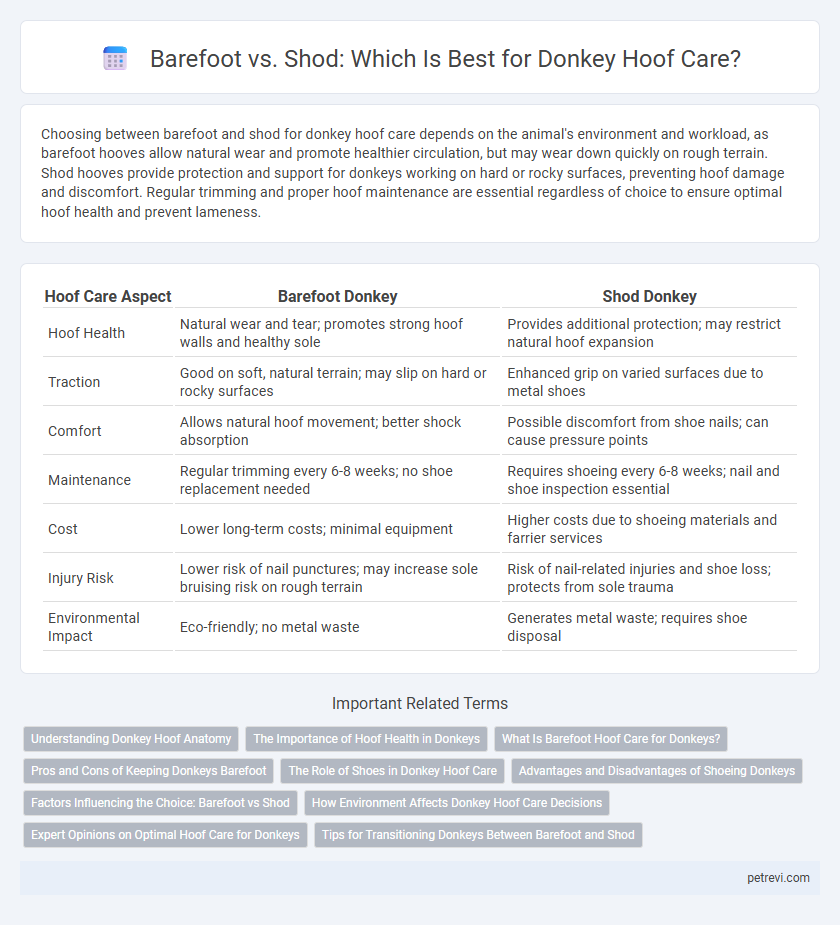Choosing between barefoot and shod for donkey hoof care depends on the animal's environment and workload, as barefoot hooves allow natural wear and promote healthier circulation, but may wear down quickly on rough terrain. Shod hooves provide protection and support for donkeys working on hard or rocky surfaces, preventing hoof damage and discomfort. Regular trimming and proper hoof maintenance are essential regardless of choice to ensure optimal hoof health and prevent lameness.
Table of Comparison
| Hoof Care Aspect | Barefoot Donkey | Shod Donkey |
|---|---|---|
| Hoof Health | Natural wear and tear; promotes strong hoof walls and healthy sole | Provides additional protection; may restrict natural hoof expansion |
| Traction | Good on soft, natural terrain; may slip on hard or rocky surfaces | Enhanced grip on varied surfaces due to metal shoes |
| Comfort | Allows natural hoof movement; better shock absorption | Possible discomfort from shoe nails; can cause pressure points |
| Maintenance | Regular trimming every 6-8 weeks; no shoe replacement needed | Requires shoeing every 6-8 weeks; nail and shoe inspection essential |
| Cost | Lower long-term costs; minimal equipment | Higher costs due to shoeing materials and farrier services |
| Injury Risk | Lower risk of nail punctures; may increase sole bruising risk on rough terrain | Risk of nail-related injuries and shoe loss; protects from sole trauma |
| Environmental Impact | Eco-friendly; no metal waste | Generates metal waste; requires shoe disposal |
Understanding Donkey Hoof Anatomy
Donkey hoof anatomy is uniquely adapted to harsh, rocky environments, featuring a tougher sole and more upright hoof angle compared to horses, which influences the decision between barefoot or shod care. Barefoot donkeys benefit from natural hoof wear and improved circulation, while challenges arise in softer or uneven terrain where protective shoes may prevent cracking and injury. Proper assessment of hoof shape, wall integrity, and terrain conditions is essential to determine optimal hoof care tailored to each donkey's anatomical needs.
The Importance of Hoof Health in Donkeys
Hoof health in donkeys is critical for their overall well-being, as healthy hooves support proper weight distribution and prevent lameness. Barefoot care allows natural wear and flexibility, promoting circulation and reducing the risk of infections, while shod hooves provide protection on rough terrains and uneven surfaces. Regular trimming and monitoring by a skilled farrier ensure optimal hoof condition, balancing protection and natural hoof function.
What Is Barefoot Hoof Care for Donkeys?
Barefoot hoof care for donkeys involves maintaining their natural hoof condition without using shoes, allowing hooves to wear down naturally through regular trimming and environmental management. This method emphasizes balanced hoof trimming to prevent cracks, splits, and infections while promoting healthy hoof growth in response to natural terrain. Proper barefoot care supports better hoof moisture regulation and stimulates natural shock absorption, reducing the risk of lameness in donkeys.
Pros and Cons of Keeping Donkeys Barefoot
Keeping donkeys barefoot promotes natural hoof wear, encouraging healthier hoof growth and reducing the risk of infections caused by trapped debris in shoes. Barefoot donkeys often experience improved circulation and less risk of hoof damage from improper shoe fitting, but they may face increased vulnerability on rough, rocky terrain leading to discomfort or injury. Regular trimming and environmental management are essential to maintain hoof integrity and prevent issues like cracks or excessive wear.
The Role of Shoes in Donkey Hoof Care
Shoes provide critical protection and support for donkeys with damaged or weakened hooves, preventing further injury and improving mobility. Properly fitted shoes help distribute weight evenly, reducing stress on sensitive areas and promoting healthier hoof growth. In environments with abrasive terrain, shoeing minimizes wear and protects against cracks and infections common in barefoot donkeys.
Advantages and Disadvantages of Shoeing Donkeys
Shoeing donkeys offers protection against rocky terrain and reduces hoof wear, which is beneficial for working donkeys in harsh environments. However, improperly fitted shoes can cause discomfort, hoof damage, and limit natural hoof expansion and contraction. Regular maintenance and expert farrier care are essential to maximize advantages and minimize disadvantages of donkey shoeing.
Factors Influencing the Choice: Barefoot vs Shod
Factors influencing the choice between barefoot and shod donkey hoof care include terrain type, workload intensity, and hoof health condition. Donkeys working on rocky or hard surfaces often benefit from shoes to prevent hoof damage and provide traction, while barefoot care suits softer, natural terrains promoting natural hoof function. Age, hoof growth rate, and presence of hoof diseases also play critical roles in determining the most suitable hoof care method.
How Environment Affects Donkey Hoof Care Decisions
Donkey hoof care decisions depend heavily on the environment in which the animals live, with barefoot management favored in soft, natural terrains to promote natural hoof wear and reduce the risk of infections. In harsher, rocky, or urban environments, shod hooves may be necessary to protect against injury and prevent excessive hoof wear. Evaluating ground conditions, moisture levels, and donkey activity informs the choice between barefoot and shod approaches for optimal hoof health.
Expert Opinions on Optimal Hoof Care for Donkeys
Experts emphasize that barefoot hoof care for donkeys promotes natural hoof function, enhancing circulation and reducing the risk of common hoof diseases. Conversely, shoeing is sometimes recommended for donkeys used in rigorous work to provide extra protection and prevent excessive hoof wear. Optimal hoof care prioritizes regular trimming every 6 to 8 weeks, proper environmental management, and consideration of the donkey's workload and terrain.
Tips for Transitioning Donkeys Between Barefoot and Shod
Transitioning donkeys between barefoot and shod hoof care requires careful monitoring of hoof health and gradual adjustment periods to prevent stress or injury. Ensure hooves are trimmed correctly by a professional farrier to promote natural shape and balance, which supports both barefoot and shod conditions. Regularly inspect for signs of discomfort or changes in gait, adapting the transition timeline based on the donkey's response and environmental footing.
Barefoot vs Shod for Donkey Hoof Care Infographic

 petrevi.com
petrevi.com